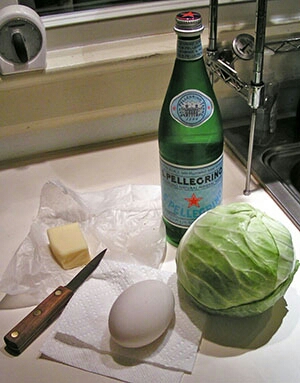
When we got our Toulouse geese a couple years ago we didn't give much thought to the eggs. It turned out our two females would lay from February through May, giving us over 100 large, rich-tasting eggs every year.
Nutritionally, goose eggs are a blessing and a curse. Like all eggs they are a complete source of protein, plus loads of folic acid, B12, and other vitamins and minerals. And then there's the cholesterol. Now, the body needs cholesterol, but be aware that a single goose egg will provide two people with their complete daily requirement. So, don't have it on top of a steak, with doughnuts.
The first thing you notice about a goose egg is that while the egg itself is large (about 2½ to 3 chicken eggs by weight) the yolk is even larger relative to the white. Also, the yolk is darker and thicker than a chicken egg, while the white is more clear and comparatively watery, even when the egg is completely fresh. That large yolk is what makes the eggs so flavorful, being about three times the size and about four times the fat of a chicken yolk.
We started out making them scrambled, and learned right away to whisk in some milk or cream or (my fave) fresh yogurt, because with the higher proportion of yolk to white they can cook up a little chalky, like the yolk of a boiled chicken egg. Also, because of their richness they can take lots of adjuncts, so we learned not to be shy about adding plenty of herbs and/or onions and/or mushrooms and/or whatever-else is on hand.
 They are also excellent for baking with; I substitute one goose egg for 1½ chicken-egg whites and 3 chicken-egg yolks.
They are also excellent for baking with; I substitute one goose egg for 1½ chicken-egg whites and 3 chicken-egg yolks.
But somehow, for some reason, although a life-long devotee of spaghetti carbonara, it had never occurred to me to try it with a goose egg. And then our March/April 2013 Cook's Illustrated arrived with an article about perfecting spaghetti carbonara. Reading it, I realized that author Celeste Rogers’ ‘perfect’ balance of yolks to whites was nearly as rich a balance as one finds in a goose egg. (Ms. Rogers’ article provides lots of insight into making carbonara come out scrumptious—I recommend it.) I made our first goose egg carbonara that night. My wife has given me permission to make it as often as once a week forevermore. What else, indeed, needs to be said?
The recipe below is sized for two servings, using a single egg and giving moderate portions. Just multiply to size up. Also, when I make it I like to tweak it, put a little jazz into it. First, any cured, fatty pork will do, and I like pancetta especially. Second, when cooking the bacon/pancetta/jowel/what-have-you, reserve a tablespoon or so of the rendered fat and whisk it into the egg(s) before putting them in the pasta. Other excellent flavor enhancers include garlic (obviously—cook it with the pork), sautéed mushrooms (can replace the pork for vegetarians), red pepper (chopped fresh or ground dry), and any diced, sautéed green vegetable. I'm planning to try asparagus next. It can also be worthwhile to play with the cheese, and any sharp, dry cheese will do. We like to use manchego, and even plain old mozzarella can be nice if there's plenty of other flavor.
Finally, note that the eggs get soft-cooked but not hard-cooked in spaghetti carbonara. If this causes anxiety you can put some heat under the pan while the spaghetti rests. Just be aware that the classic creamy smoothness will likely be replaced by curdle and paste. It will still taste amazing though.
|
Goose Egg Carbonara |
||||||||||||||||||||||||||||
|
||||||||||||||||||||||||||||
|
||||||||||||||||||||||||||||
|
Servings: 2 Yield: 3 cups |
||||||||||||||||||||||||||||
|
Nutrition Facts
|
||||||||||||||||||||||||||||
